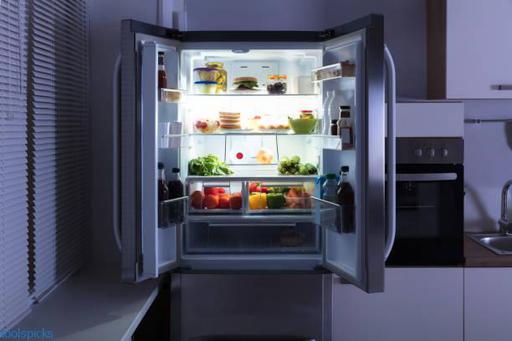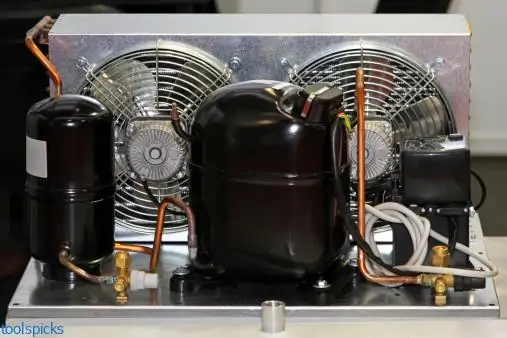What amp breaker for refrigerator? A 15-amp circuit breaker is needed for most refrigerators. If your fridge is bigger or uses more electricity, you might need a 20-amp breaker. Check the owner’s manual to be sure. Usually, the specs are in the section called “electrical requirements.”
If you don’t know what size circuit breaker to use, you should talk to a licensed electrician.
When in doubt, always err on the side of caution and use a bigger circuit breaker than is needed. This will keep your circuit breaker from getting too hot and shutting off.
How Much Power Does A Refrigerator Consume?
The average refrigerator consumes 725 watts of power and 15 to 20 amps, which can account for up to 10% of total energy consumption in your home. Certain technical terms must be understood in order to comprehend.
Wattage is the amount of energy that is normally turned into electricity every hour. It is measured in watts. At the very least, your refrigerator should have come with a label showing how energy efficient it is. You can use this number to figure out how many amps your unit has.
Once you know how many watts your refrigerator uses, you can figure out how many amps it uses. The wattage of the device divided by the voltage is equal to the amperage, or Amperage = Watts/Voltage. In American homes, the standard voltage is 120 volts.
What Amp Breaker Do I Need For A Refrigerator?
Is a problem that is common in older homes. If too many kitchen appliances are used at once, the circuit will be shortened. This means that every light and appliance on the circuit will turn off at the same time.
By stopping the flow of electricity to certain parts of your home, circuit breakers keep you from overloading your electrical system.
Refrigerators need a 115- or 120-volt, properly grounded, separate branch circuit with a 15- or 20-amp circuit breaker or a time-delay fuse.
Refrigerators should be plugged into a separate circuit, and it’s important to remember that the amps and watts needed to start them up are usually three times higher than the amps and watts needed to run them.
The amount of electricity flowing through a circuit is measured in amperes. Amps are used to measure current. To keep a wire from overheating, use the right wire size for the needed amps. A standard residential circuit is 20 amps.
Voltage is the force that pushes electricity through a wire. In the United States, there are two standard voltages: 110V and 220V.
Single pole circuit breakers
These are the most common kinds of circuit breakers in homes. Single pole breakers protect one wire that is wired to electricity. They may offer a 120-volt circuit with 15 to 20 amps.
Circuit breakers with two prongs
This type of breaker protects two live wires and takes up two slots in the breaker panel. They can send between 15 and 200 amps and up to 240 volts to a circuit. This kind of circuit breaker is needed for big appliances like dryers, dishwashers, and refrigerators.
How Many Amps Does A Refrigerator Compressor Draw?
The amount of electricity a refrigerator compressor needs to cool the compartment is measured in amps. For refrigerators with 120 V, the amperage ranges from 3 to 5. Since the starting current is much higher, a dedicated 15- to 20-amp circuit is needed. Check the compressor’s energy use and the manufacturer’s overall recommendations.
When in doubt, always err on the side of caution and use a bigger circuit breaker than is needed. This will keep your circuit breaker from getting too hot and shutting off.
For refrigerators with 120 V, the amperage ranges from 3 to 5. Since the starting current is much higher, a dedicated 15- to 20-amp circuit is needed.
Check the compressor’s energy use and the manufacturer’s overall recommendations. When in doubt, always err on the side of caution and use a bigger circuit breaker than is needed. This will keep your circuit breaker from getting too hot and shutting off.
As a general rule, you should always do these things: A 120-volt circuit can support 15 or 20 amps, but a 240-volt circuit can support 30 or 40 amps. These are just general tips, and if you have any questions, you should always talk to an electrician.
The simple thing to do is to connect your refrigerator to a circuit that is only for it and is not overloaded. This will help keep your refrigerator and electrical system in good shape.
Do I Need A Dedicated Circuit For A Refrigerator?
Stoves, refrigerators, microwaves, toasters, and coffee makers use a lot of power, so planning the kitchen circuitry is an important part of building a new home. In older homes built before modern appliances were common, a single circuit was usually enough to meet the kitchen’s electrical needs. When multiple pieces of modern kitchen equipment are used at the same time, the circuit breaker may trip. One way to avoid this risk is to set up a separate circuit for the refrigerator.
Installing a dedicated circuit for the refrigerator will make it run more efficiently and keep the home’s wiring from getting too full.
Most home refrigerators use between 500 and 750 watts of power when they are working normally. A 110-volt appliance that uses 750 watts will need 6.8 amps. Watts divided by Volts = Amperes is the formula for converting watts to amps. On a regular 15-amp circuit, a refrigerator will use about half of the available amperage. On a 20-amp circuit, it will use more than one-third of the available amperage.
Don’t forget to leave a 20–30% buffer. During normal operation, a circuit should only carry 80 percent of its rated load. Under these conditions, a 15-amp circuit could only handle 12 amps of load. With a circuit load of 6.8 amps, the recommended working reserve capacity is only 5.2 amps. Increasing the capacity to 20 amps will make it safer, but you should still be careful. A 15 amp circuit probably wouldn’t have enough power left to run a microwave or toaster while the refrigerator’s compressor is running, which would cause the circuit breaker to trip.
Another reason why refrigerators need their own circuit is that power outages can happen without warning. If the circuit is overloaded, the breaker will cut the power to it. When this happens, the power won’t work until the circuit breaker is reset by hand. If the power is out for only a few minutes, this won’t be a big deal. If the power goes out while the homeowner is gone for a long time, the food in the fridge and freezer may go bad.
How Many Amps Does A 12-Volt Fridge Draw?
on average, 5 amps To do this, divide Watts by Volts to get Amps per hour. When running, a refrigerator motor with 60 watts and 12 volts uses 5 amps, or 60/12 = 5 amps.
When planning a new kitchen or an upgrade, you should think about the circuits and the amperage of the refrigerator.
Take precautions!
Final Thoughts
A refrigerator is an essential household appliance and one that you likely use on a daily basis. It’s important to ensure that your fridge is properly plugged in and receiving the right amount of power. In most cases, a dedicated circuit is the best way to power your fridge. This will help to prevent any Circuit Breaker trips and will ensure that your fridge is running at peak efficiency. When in doubt, consult with a qualified electrician to ensure that your home is properly wired and that your fridge is receiving the right amount of power. Thanks for reading!



